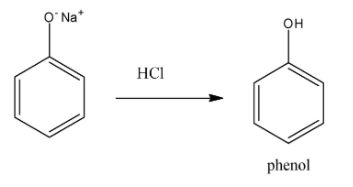
Convert chloro benzene to phenol.
Answer
416.8k+ views
Hint: We know that Dow's process is one of the ways of conversion of chlorobenzene to phenol. To obtain phenol from chlorobenzene, first we have to react with chlorobenzene with sodium hydroxide, then phenoxide ion forms. The acidification of phenoxide ions results in phenol.
Complete answer:
In Dow's process, hydrolysis of chlorobenzene results in phenol. First step is treating chlorobenzene with aqueous sodium hydroxide at a temperature of 623 K and pressure of 300 bar to convert it into sodium phenoxide.
Now, we write the reaction of formation of sodium phenoxide ion by reaction of chlorobenzene with sodium hydroxide.

The next step is the acidification of phenoxide ions. This can be done by reacting phenoxide ion with hydrochloric acid. The result of this reaction is the production of phenol.
Now, we write the reaction of production of phenol by acidification of phenoxide ions.

Hence, by Dow’s process, we are able to convert chloro benzene to phenol by Dow’s process.
Additional information:
When one hydrogen atom of the benzene ring is replaced by a hydroxide ion, then the compound is known as phenol. Phenols are commonly used as intermediates in industrial synthesis and in household products. For example, phenol is used as a disinfectant (in low concentrations) in household and mouthwash cleaners. Phenol was probably the first antiseptic surgery. Phenol is also known as carbonic acid, hydroxybenzene and phenolic acid.
Note:
Another way to convert chlorobenzene to phenol is by reacting phenol with steam at 698 K in presence of calcium phosphate. The reaction gives phenol and hydrochloric acid.

Complete answer:
In Dow's process, hydrolysis of chlorobenzene results in phenol. First step is treating chlorobenzene with aqueous sodium hydroxide at a temperature of 623 K and pressure of 300 bar to convert it into sodium phenoxide.
Now, we write the reaction of formation of sodium phenoxide ion by reaction of chlorobenzene with sodium hydroxide.

The next step is the acidification of phenoxide ions. This can be done by reacting phenoxide ion with hydrochloric acid. The result of this reaction is the production of phenol.
Now, we write the reaction of production of phenol by acidification of phenoxide ions.

Hence, by Dow’s process, we are able to convert chloro benzene to phenol by Dow’s process.
Additional information:
When one hydrogen atom of the benzene ring is replaced by a hydroxide ion, then the compound is known as phenol. Phenols are commonly used as intermediates in industrial synthesis and in household products. For example, phenol is used as a disinfectant (in low concentrations) in household and mouthwash cleaners. Phenol was probably the first antiseptic surgery. Phenol is also known as carbonic acid, hydroxybenzene and phenolic acid.
Note:
Another way to convert chlorobenzene to phenol is by reacting phenol with steam at 698 K in presence of calcium phosphate. The reaction gives phenol and hydrochloric acid.

Recently Updated Pages
JEE Main 2023 (January 30th Shift 2) Maths Question Paper with Answer Key

JEE Main 2022 (July 25th Shift 2) Physics Question Paper with Answer Key

Classification of Elements and Periodicity in Properties Chapter For JEE Main Chemistry

JEE Main 2023 (January 25th Shift 1) Maths Question Paper with Answer Key

JEE Main 2023 (January 24th Shift 2) Chemistry Question Paper with Answer Key

JEE Main 2022 (June 29th Shift 2) Maths Question Paper with Answer Key

Trending doubts
JEE Main 2025 Session 2: Application Form (Out), Exam Dates (Released), Eligibility & More

JEE Main Correction Window 2025 Session 2 (Open) Live Updates – Form Correction Link, Fees, Steps

JEE Main 2025: Conversion of Galvanometer Into Ammeter And Voltmeter in Physics

Learn About Angle Of Deviation In Prism: JEE Main Physics 2025

Electromagnetic Waves Chapter - Physics JEE Main

The coordination number of an atom in a fcc lattice class 12 chemistry JEE_Main

Other Pages
NCERT Solutions for Class 12 Chemistry Chapter 6 Haloalkanes and Haloarenes

NCERT Solutions for Class 12 Chemistry Chapter 2 Electrochemistry

NCERT Solutions for Class 12 Chemistry Chapter 7 Alcohol Phenol and Ether

NCERT Solutions for Class 12 Chemistry Chapter 8 Aldehydes Ketones and Carboxylic Acids

NCERT Solutions for Class 12 Chemistry Chapter 9 Amines

NCERT Solutions for Class 12 Chemistry Chapter 3 Chemical Kinetics




